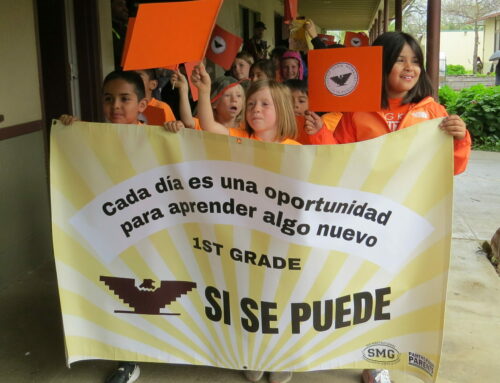Published in the March 30 – April 12, 2016 issue of Morgan Hill Life
By Heather Oliver’s fourth-grade class at Barrett Elementary School

Photo by Marty Cheek
Thomas Dermody shows Barrett Elementary School fourth graders how his robot “Nao” communicates.
A scientist named Thomas Dermody came to Barrett Elementary School March 21 and showed us how robotics work. He showed us a robot named “Nao” that danced and answered questions.
“You can ask me questions if you want,” said the humanoid robot.
“How old are you?” asked Dermody.
“Speak louder, please,” the machine said.
“How old are you?” Dermody repeated.
“I’ll be nine this year. Give me a pat on the head, please.”
And Dermody patted the robot on the head.
Robots have lots of history. They go all the way to at least 1495 when Leonardo da Vinci drew in one of his notebooks an illustration for an “automaton,” which is a kind of doll that had gears in it that made it move.
People don’t know if he actually tried to make it, but many centuries later someone did make it to see if it might work. Da Vinci had a lot of imagination in his brain to see something that could not actually be built in his own time of the Italian Renaissance, but that would someday in the future be built.
The word “robot” comes from the Czech word for “slave.” It was used for the first time when a playwright named Karel Capek wrote a science fiction play called “R.U.R.” (which stands for “Rossum’s Universal Robots”) produced for the stage in 1920.
Robots are made out of metal and plastic. They need some kind of control device such as a voice command – much like Nao has. Robots have gears and motors to allow them to move. Their battery contains electricity which moves through the wired circuits of the robot and gives it energy to dance and walk.
Scientists use computer chips to program the robots with software language and that tells the robot what to do. Sensors embedded in the robot tell it what is happening in the outside so that robot can react and take action based on what’s occurring to it.
We enjoyed when the Nao robot started performing a Gangnam-style dance and all the students in the assembly were amazed and laughed.
We also learned that electricity can flow in a closed circuit when Dermody did an experiment where he had an electric light bar and various students joined hands and closed the circuit, causing the lights to move. When the students only touched each other by their finger tips, the light blinked slower because there was less of a connection.
Robots are important to the future of our world because they can be our servants. But we need to be careful not let them take over the world in a robot apocalypse.
After a junior journalism workshop with Publisher Marty Cheek, Heather Oliver’s fourth-grade class wrote this column for Morgan Hill Life.






